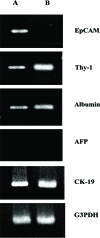Isolation of Hepatic Progenitor Cells From Human Liver With Cirrhosis Secondary to Biliary Atresia Using EpCAM or Thy-1 Markers
- PMID: 28058189
- PMCID: PMC5196935
- DOI: 10.3727/215517912X639441
Isolation of Hepatic Progenitor Cells From Human Liver With Cirrhosis Secondary to Biliary Atresia Using EpCAM or Thy-1 Markers
Abstract
We sought to determine whether hepatic progenitor cells can be isolated from cirrhotic liver using epithelial cell adhesion molecule (EpCAM) or Thy-1 markers. Liver tissue with cirrhosis secondary to biliary atresia (BA) was collagenase digested, and nonparenchymal cells (NPCs) were cultivated for 24 h. Noncirrhotic NPCs derived from patients with carbamyl phosphate synthetase and ornithine transcarbamylase deficiencies were used as controls. Flow cytometric analysis demonstrated that the percentages of EpCAM- and Thy-1-positive cells were significantly higher in NPC populations derived from BA liver than in those derived from control liver. Reverse transcription polymerase chain reaction analysis revealed that EpCAM-positive sorted cells expressed EpCAM, Thy-1, albumin, and CK-19, whereas Thy-1-positive sorted cells expressed Thy-1, albumin, and CK-19. These findings indicate that EpCAM- or Thy-1-positive hepatic progenitor cells can be more efficiently isolated from BA liver than from control liver and suggest that the properties of EpCAM-positive cells are somewhat different from those of Thy-1-positive cells.
Keywords: Biliary atresia; Cirrhosis; EpCAM; Flow cytometry; Hepatic progenitor cells; Thy-1.
Figures





References
-
- Crosby H. A.; Kelly D. A.; Strain A. J. Human hepatic stemlike cells isolated using c-kit or CD34 can differentiate into biliary epithelium. Gastroenterology 120:534–544;2001. - PubMed
-
- Enosawa S. Hepatocyte isolation from human liver tissue. Organ Biol. 16:361–370;2009.
-
- Herrera M. B.; Bruno S.; Buttiglieri S.; Tetta C.; Gatti S.; Deregibus M. C.; Bussolati B.; Camussi G. Isolation and characterization of a stem cell population from adult human liver. Stem Cells 24:2840–2850;2006. - PubMed
LinkOut - more resources
Full Text Sources
Research Materials
Miscellaneous

